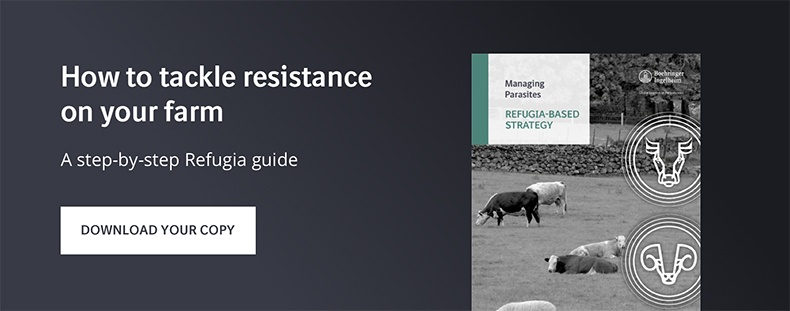Parasites reduce average daily liveweight gain
Parasite burdens in growing beef cattle are known to reduce average daily liveweight gain and slow growth. This leads to reduced performance and increased costs, which erodes the already-tight margins in beef production.
Winter is an ideal opportunity to remove productivity-limiting parasites that were picked up during summer grazing. This is particularly the case where cattle are brought in from pasture and housed, since they will not acquire further parasite burdens until turnout.
Even without producing clinical signs of disease, gutworms may significantly impact on the performance of cattle. A gutworm burden causes cattle to eat less, reducing their nutrient intake. It also negatively impacts on feed efficiency.
Protein resources stage immune response rather than growth and weight gain
When faced with a parasite challenge, animals will direct protein resources towards staging an immune response rather than growth and weight gain, which will compound the impact on performance.
The use of wormers or anthelmintics has been shown to contribute to improvements in animal health, enhanced performance, and productivity through the removal of parasites1.
In trials with beef cattle, pregnancy rates increased following anthelmintic treatment, up to 120%2. This will vary, depending on specific nutritional, environmental and genetic conditions of the animals.
Weight gain in growing animals can also be optimised by appropriate use of anthelmintics, with studies showing weaning weight increases of up to 13%4.
Risk of parasitic gastroenteritis
For young cattle at pasture, the risk of parasitic gastroenteritis (PGE) may continue into the autumn if weather conditions remain favourable.
PGE results from infection with high numbers of Ostertagia ostertagi and other worm species, and is characterised by profuse diarrhoea and weight loss.
A high challenge from Ostertagia ostertagi can also cause type 2 ostertagiosis. This parasitic disease results from the mass emergence of encysted worm larvae from the stomach wall in the late winter/early spring. This causes severe scouring and can result in death.
Although uncommon, the risk of type 2 ostertagiosis is greatest when parasites have been poorly controlled during the grazing season, and when a housing treatment with good efficacy against the encysted form of this parasite has not been used.
Safeguard the productivity of young cattle with suitable wormer
To prevent parasitic disease and safeguard the productivity of young cattle, a housing treatment with a suitable wormer should be considered.
Grazing management practices will heavily influence exposure to gutworm larvae. Understanding this risk and assessing pastures on the farm is useful to identify which cattle are likely to have been exposed to parasites during the grazing season. This assessment can help inform treatment decisions.
Individual weight gains can also provide an indication of whether animals are facing a high parasite challenge and would benefit from targeted treatment.
Faecal egg counts can provide an indication of the dynamics of worm infection over the grazing season, but provide a less reliable means of assessing worm burdens in individual animals.
Products containing ivermectin are effective against gutworm and external parasites
Products containing ivermectin (such as IVOMEC® Classic Injection or Pour-on) or eprinomectin (such as EPRINEX® Pour On in the UK and EPRINEX® Multi Pour On in Ireland) are effective against all stages of gutworm and against external parasites.
Combination products offer a practical treatment choice when they allow a number of the parasites being targeted to be treated with one product. IVOMEC® Super (containing ivermectin and clorsulon) is effective against gutworm, the adult stages of fluke and external parasites.
Treat the early immature stage of liver fluke
The choice of treatment for liver fluke at housing is complicated by emerging resistance to triclabendazole. This is the only flukicide which treats the early immature stage of liver fluke, which causes acute disease in sheep but does not cause disease in cattle.
Selecting an alternative flukicide for cattle at housing will reduce selection for resistance and, by targeting the later stages of the parasite, control the impact of liver fluke on productivity.
Flukicides containing clorsulon (contained in IVOMEC® Super) will remove the adult stages of fluke in cattle, while those containing closantel or nitroxynil, the active ingredient of TRODAX®, are effective against both late immature and adult stages.
To ensure that cattle have no residual fluke burden, they may need to be retreated at an appropriate interval after the initial housing dose. Diagnostic testing can be used to determine whether a second treatment is necessary. This approach will ensure that cattle are turned out fluke free.
Advice on the most appropriate product and treatment protocol for your farm should be obtained from your vet or animal health advisor.
Best practice parasite treatment principles
Once the choice of treatment has been determined, it’s vital that they are applied using best practice principles:
- Maintain all equipment and cattle handling facilities
- Use the most appropriate product for the parasites present.
- Store and handle products safely and correctly.
- Accurately determine the weight of animals to ensure you use the correct dose
- Use the correct applicator for the product
- Consult the label and/or datasheet before using a product.
Click here for product legal furniture.
